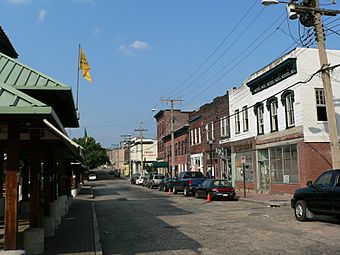Shockoe Valley facts for kids
|
Historic Shockoe Valley
|
|

View north on 17th Street
|
|
| Location | Roughly bounded by the James River, 12th, Main, 14th, Broad, I-95, Clay, Cedar, Marshall, 21st, Franklin, 25th, Main, and Peach Sts., Richmond, Virginia |
|---|---|
| Area | 129 acres (52 ha) |
| Architectural style | Mid 19th Century Revival, Late 19th and 20th Century Revivals, Late Victorian |
| NRHP reference No. | 83003308 |
Quick facts for kids Significant dates |
|
| Added to NRHP | February 24, 1983 |
Shockoe Valley is a historic area in Richmond, Virginia. It is located just east of the city's downtown area, right along the James River. Today, it is known as a lively entertainment spot.
Shockoe Valley sits between Shockoe Hill and Church Hill. This area was part of Richmond's original design from 1737. This makes it one of the oldest neighborhoods in the city. Inside Shockoe Valley, you'll find smaller neighborhoods like Shockoe Slip, Shockoe Bottom, and Tobacco Row.
Exploring Shockoe Valley's Past
How Shockoe Valley Began
Shockoe Valley started to grow in the late 1700s. This happened after Richmond became the state capital. Building Mayo's bridge across the James River helped a lot. This bridge was later replaced by the modern 14th Street Bridge. Key tobacco buildings were also built here. These included public warehouses and the Federal Customs House.
Fires and Rebuilding in the 1800s
In April 1865, the American Civil War was ending. Confederate forces were leaving Richmond. They were told to burn the city's tobacco warehouses. The fires spread quickly. They completely destroyed Shockoe Slip and other areas.
But the district was rebuilt fast in the late 1860s. It grew even more in the 1870s. Many of the historic buildings you see today were built during this time.
Shockoe Valley's Role in Trade
Throughout the 1800s, Shockoe Valley was Richmond's main business hub. Ships would arrive from the James River. Goods from these ships were stored and traded here. Tobacco was one of the main goods.
The History of Slavery in Shockoe Valley
Before the Civil War ended in 1865, this area played a big part in the history of slavery. It was the second largest center for trading enslaved people in the United States. Only New Orleans was larger. The money made from this trade helped create wealth for many people. It also boosted Richmond's economy.
Because of this, 15th Street was known as "Wall Street" before the war. The blocks around it had more than 69 slave dealers and auction houses. In 2006, archaeologists started digging at the site of Lumpkin's Jail. This was a place where enslaved people were held.
Changes Over Time
After the big fire of 1865, many buildings were rebuilt. They often had a commercial style. A fountain from 1909 was also added. It was dedicated to "one who loved animals."
These buildings once held offices, shops, and wholesale businesses. Today, many are restaurants, stores, offices, and apartments. The area started to decline in the 1920s. Other parts of the city became more important as cars became popular. Many buildings were torn down. This included the Tobacco Exchange in the 1950s. Large tobacco companies were in Tobacco Row until the 1980s.
Bringing Shockoe Valley Back to Life
Starting Fresh in the 1960s and 70s
In the 1960s and 1970s, Shockoe Valley began to change. It was redeveloped into a place for businesses and fun. Nightlife grew after Richmond allowed liquor sales in restaurants. People also became more interested in saving historic places. This was around the time of the United States Bicentennial (200th anniversary). The district was added to the National Register of Historic Places in 1972. Some of the first new restaurants included The Tobacco Company and Sam Miller's.
Growth and Challenges in Recent Years
Shockoe Valley became a major entertainment area in the late 1900s. The James River Flood Wall and the Canal Walk were finished in 1995. This helped the area grow a lot by protecting it from floods.
However, in 2004, Hurricane Gaston caused a different kind of flood. Heavy rains damaged many businesses and buildings.
Shockoe also saw some of the first downtown apartments. Old asphalt roads were removed to show the historic Belgian block streets underneath.
New Developments and the Future
A big boost in housing happened in the mid-1990s. Old warehouses in Tobacco Row were turned into apartments. Since then, more empty buildings have become homes. New buildings have also been constructed. More good restaurants have moved into the area.
Currently, Shockoe Valley needs more retail stores and tourism. The "Revitalize RVA" plan aims to change this. It could bring new apartments, a grocery store, and a hotel. These would be built around a new stadium.
Other projects are also planned:
- The 17th Street Farmer's Market will become an open-air pedestrian mall. It will have outdoor dining for restaurants.
- The Main Street Station's Train Shed will become an urban market. It will have bike storage and a bus station.
- Lumpkin's Jail will become the Slavery and Freedom Heritage Center.
The future of Shockoe Valley is expected to be a center for entertainment and tourism in Richmond.
 |
Court End | Upper Shockoe Valley | Union Hill |  |
| Capitol Hill | Church Hill | |||
| Manchester and Mayo Bridge over the James River |
Rockett's Landing |



